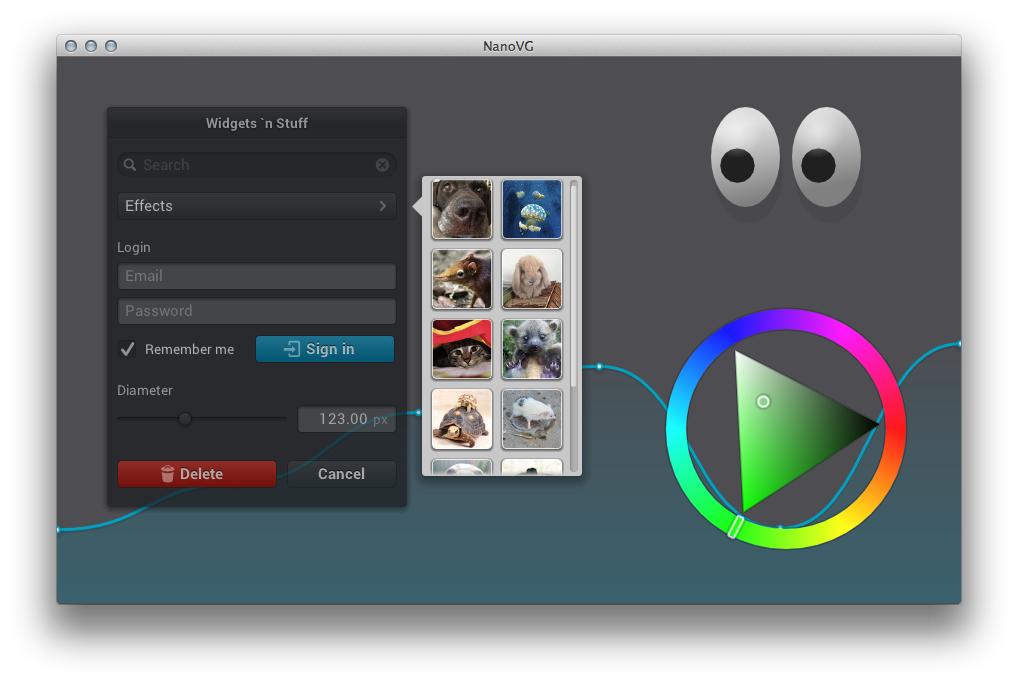/work in progress.../
NanoVG
NanoVG is small antialiased vector graphics rendering library for OpenGL. It has lean API modeled after HTML5 canvas API. It is aimed to be a practical and fun toolset for building scalable user interfaces and visualizations.
Screenshot
Usage
The NanoVG API is modeled loosely on HTML5 canvas API. If you know canvas, you're up to speed with NanoVG in no time.
Creating drawing context
The drawing context is created using platform specific constructor function. If you're using the default OpenGL 2.0 back-end the context is created as follows:
struct NVGcontext* vg = nvgCreateGL2(512, 512, NVG_ANTIALIAS);
The two values passed to the constructor define the size of the texture atlas used for text rendering, 512x512 is a good starting point. If you're rendering retina sized text or plan to use a lot of different fonts, 1024x1024 is better choice.
Currently there are two different back-ends for NanoVG: nanovg_gl2.h for OpenGL 2.0 and nanovg_gl3.h for OpenGL 3.2 core profile.
Drawing shapes with NanoVG
Drawing a simple shape using NanoVG consists of four steps: 1) begin a new shape, 2) define the path to draw, 3) set fill or stroke, 4) and finally fill or stroke the path.
nvgBeginPath(vg);
nvgRect(vg, 100,100, 120,30);
nvgFillColor(vg, nvgRGBA(255,192,0,255));
nvgFill(vg);
Calling nvgBeginPath() will clear any existing paths and start drawing from blank slate. There are number of number of functions to define the path to draw, such as rectangle, rounded rectangle and ellipse, or you can use the common moveTo, lineTo, bezierTo and arcTo API to compose the paths step by step.
Understanding Composite Paths
Because of the way the rendering backend is build in NanoVG, drawing a composite path, that is path consisting from multiple paths defining holes and fills, is a bit more involved. NanoVG uses even-odd filling rule and by default the paths are wound in counter clockwise order. Keep that in mind when drawing using the low level draw API. In order to wind one of the predefined shapes as a hole, you should call nvgPathWinding(vg, NVG_HOLE), or nvgPathWinding(vg, NVG_CV) after defining the path.
nvgBeginPath(vg);
nvgRect(vg, 100,100, 120,30);
nvgCircle(vg, 120,120, 5);
nvgPathWinding(vg, NVG_HOLE); // Mark circle as a hole.
nvgFillColor(vg, nvgRGBA(255,192,0,255));
nvgFill(vg);
Rendering is wrong, what to do?
- make sure you have created NanoVG context using one of the
nvgCreatexxx()calls - make sure you have initialised OpenGL with stencil buffer
- make sure you have cleared stencil buffer
- make sure all rendering calls happen between
nvgBeginFrame()andnvgEndFrame() - make sure you have following OpenGL state between calls to
nvgBeginFrame()andnvgEndFrame():glEnable(GL_CULL_FACE)glCullFace(GL_BACK)glEnable(GL_BLEND)glDisable(GL_DEPTH_TEST)
- if the problem still persists, please report an issue!
API Reference
See the header file nanovg.h for API reference.
License
The library is licensed under zlib license
Discussions
Links
Uses stb_truetype for font rendering. Uses stb_image for image loading.
